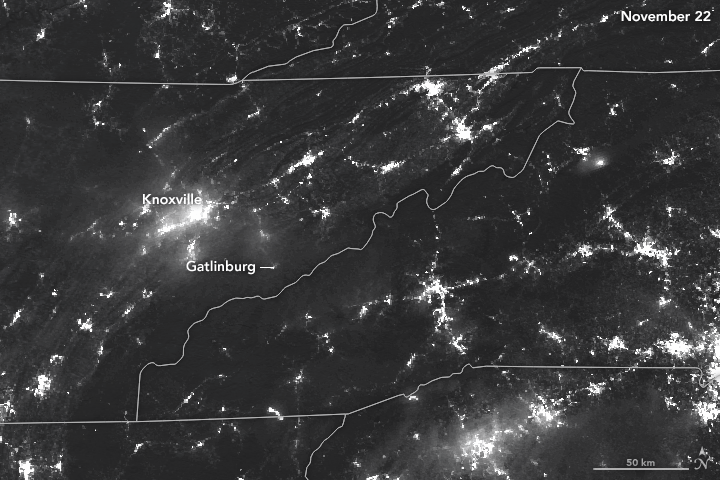

The Great Smoky Mountains are named for the blue haze that often hangs over the mountains due to volatile chemicals released by pine forests. But in November 2016, the Smokies lived up to their name for a very different reason.
With drought gripping the southeastern U.S., intense and destructive wildfires have raged in North Carolina, Tennessee, Georgia, and South Carolina for much of November. The Moderate Resolution Imaging Spectroradiometer (MODIS) on NASA’s Terra satellite captured a natural-color image (top) of smoke billowing from several of the fires on November 27, 2016.
Two days later, blazes forced the evacuation of 14,000 people from Gatlinburg, Tennessee, a town popular among tourists visiting Great Smoky Mountains National Park. Unusually strong winds invigorated the fires overnight, and hundreds of buildings were damaged or destroyed in Gatlinburg, according to the Tennessee Emergency Management Agency. More than 11,000 people lost power. The national park, the most visited in the country, was forced to close.

On November 29, 2016, the Visible Infrared Imaging Radiometer Suite (VIIRS) on the Suomi NPP satellite captured a nighttime image of the fire in Tennessee. (For comparison, it is paired with an image of the same area on November 22.) Clouds blocked most of the city lights on November 29, but the blaze was so bright that it illuminated the cloud deck just east of Gatlinburg. The fire was imaged by a special “day-night band” that detects light in a range of wavelengths from green to near-infrared and uses light intensification to detect dim signals.
The ongoing—and in some areas record-breaking—drought in the southern Appalachians started in May 2016 and intensified throughout the summer. Many areas have experienced their hottest and driest autumn on record. While a storm system brought some rain to the region on November 29, the Tennessee Emergency Management Agency does not expect that it will bring immediate relief to areas where the fires are burning.
In addition to the drought and winds, other factors have intensified the fires. Decades of aggressive fire suppression have primed forests to burn, and outbreaks of insects such as the southern pine beetleand hemlock wooly adelgid have left large stands of dead trees.